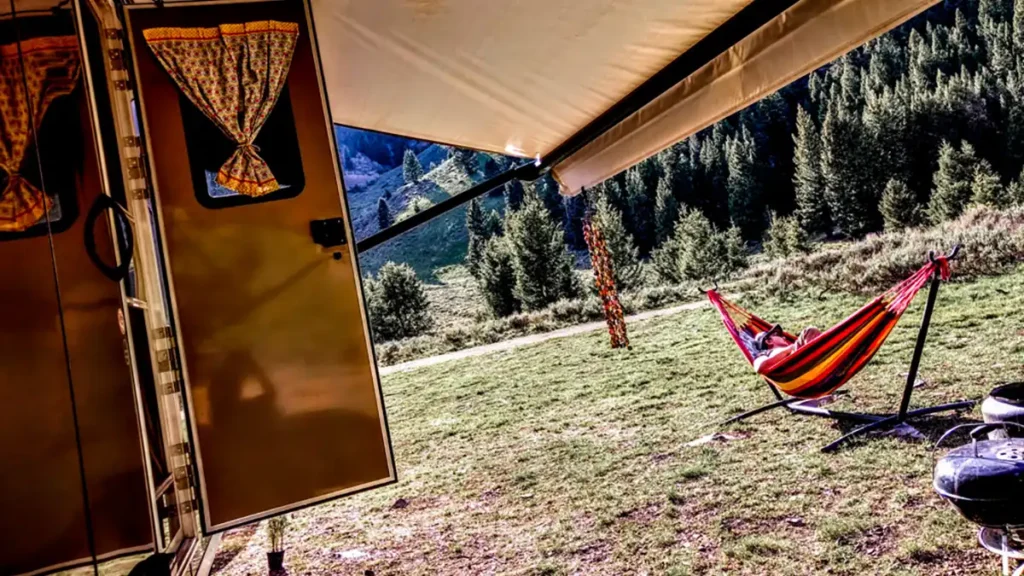It is definitely cheaper to boondock than staying in RV parks. However, there are some RV parks located in remote towns where the monthly rate is so low, that it can be cheaper to stay there instead. However if you prefer a change of scenery every couple of weeks, boondocking is cheaper.

Is It Cheaper to Boondock Than Staying in RV Parks?
In most cases, the answer is “yes”, it’s cheaper to boondock than to stay in RV parks. But it depends on what RV park you’re comparing it to, and how long you want to remain stationary.
Some RV parks located in remote areas will offer monthly rates so low that you can save more money staying there than by boondocking. It’s common for some of these parks to offer monthly rates as low as $150.00 a month, and still offer you water and sewage with additional electricity.
However, low-budget RV parks tend to be unkempt, dirty, or populated with undesirable folks.
RV Parks versus Boondocking
Based on RV park rates and fuel prices in 2023…
- Monthly rates at RV parks average about $800.00 per month. There are plenty of cheaper places and pricier places.
- There is no cost to boondocking on public lands.
- Cost of spending fuel while staying at an RV park for a month is limited to what driving you do around town, and then the cost of moving your RV out of the park and on to the next. For your toad, you may spend $100.00 in that month, and then $300.00 to move it 200 miles away after you check out.
- Cost of spending fuel while boondocking is similar, except you’ll have to pack up and move after two weeks, then drive 200 miles to the next boondocking site, and then drive another 200 miles after that two weeks is up. There’s also the cost of driving around town for errands, except you now have a pickup truck instead of a toad. We’re spending $600.00 on fuel in that month, and $200.00 on fuel running errands.
- RV parks will charge you separately for electricity when paying the monthly rate. After a month’s stay, it’s common to pay $150.00 for juice.
- Boondocking will demand that you run a generator to power your air conditioning, microwave, and other high-draw items. It’s cheaper overall due to many fuel-efficient generators that can power down during light loads. We price it at $75.00 a month.
- Water and sewage is bundled into the price of staying at an RV Park.
- Water and sewage when boondocking is based on how much you pay at dump stations, and how much fuel you consume driving your RV there. Dump stations at federally-operated campgrounds are often free. We price it at $40.00 per month.
- Propane usage at an RV Park drops is much less due to available electricity to run a refrigerator and water heater. Though propane is still used to run the furnace and the burners on a stove top. After a month you will refill one 5-gallon tank at a price of $40.00.
- Propane usage while boondocking is heavy and will often require refilling two 5-pound tanks after a month at a price of $80.00
Total for month’s stay at an RV Park: $1,390.00
Total for month’s stay boondocking: $995.00
Note: the above two figures are generous, considering average use by two adults in medium-to-large sized RVs. Boondockers tend to be more frugal and can get that cost down to $500.00 a month. Read our other article, “How Much Money Do I Need to Make To Live Full Time Boondocking?“
Air Conditioning While Boondocking versus RV Parks
If it’s necessary for you to remain in hot weather, then it may be wiser to just pull into a budget RV Park and pay the monthly rate. You’ll still have to pay separately for electricity, but the cost savings of the monthly rate will usually make it worthwhile.
By contrast, boondocking in triple-digit temperatures is tough to do. RV air conditioning units can only cool down to about 20 degrees lower than outside air. Either you’ll have to run your RV air conditioning units 24 hours a day, or you’ll never get any sleep. Running your generator 24 hours a day may cost you $450.00 a month if using a fuel-efficient generator, or as high as $1,000.00 running an Onan generator.
In reality, boondockers don’t camp in triple-digit heat. They move to high ground at elevations of 7,000 feet and higher.
The Cost of Moving an RV
It doesn’t matter if you’re staying in RV Parks or boondocking. At some point, you must pack up camp and move out. Moving your RV down the road is expensive. If you’re traveling just 200 miles from one camp to the next, expect to pay $200.00 in fuel for a medium-to-large sized RV.
The difference with RV Parks is that you can stay a full month and minimize your travel. With boondocking, you typically can only remain camped for 14 days maximum before you are required to move out.
Refilling Fresh Water and Dumping Sewage Necessitates Moving
Many novice boondockers end up using up too much water, forcing them to pack up camp to refill their water tanks. The more you conserve water, the less often you have to spend money on fuel moving your RV.
The same is true with sewage tanks. When that black tank or gray tank fills up, you’re forced to pack up camp and move.
Fortunately, there are ways to conserve water and stretch your sewage tank usage…
- How to Take a Shower When Boondocking
- Reasons Why Your RV Black Tank Fills Up Too Fast
- Can I Dump My Gray Water on the Ground?
- 30 Tips to Make Your RV Water Tank Last for a Month
- How Much Water Do I Need For Boondocking?
How Much Does it Cost to Outfit an RV for Boondocking?
It’s not uncommon for some boondockers to spend $20,000.00 outfitting their rigs with solar panels, batteries, and more energy efficient appliances. However, the average boondocker spends much less than that, usually closer to $2,000.00.
Most RV manufacturers do not design motorhomes and trailers for boondocking, and certainly do not design them for full time use either. An RV would cost three to four times more if they were built to the higher standards necessary to withstand rugged roads, off-grid camping, and year-round use.
RVs that come with solar panels as standard equipment usually only have a single panel ranging between 100 to 150 watts. That will not generate enough electricity to run anything at all. It’s only enough to send a trickle charge of power to maintain an RV’s house batteries. In order to generate enough electricity to run kitchen appliances and personal electronics, you will need a minimum of 600 watts of solar panels (4-6 panels), and a minimum of 200 amp hours in batteries (two 12v or two 6v units). Read our other article, “How Many Solar Panels Do I Need for Boondocking?“
The tires that RVs come with are always cheap, Chinese-made productions. Most boondockers will change them out for more rugged, US-made tires.


Hello around the bay area where is a good boondocks spots around